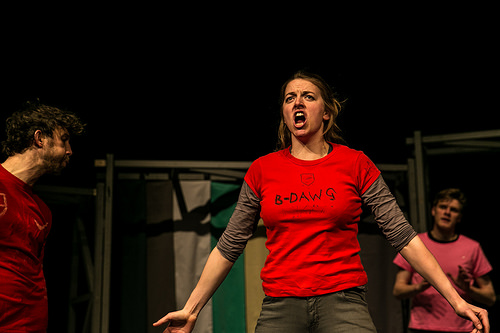@ King’s Theatre, Edinburgh, until Sat 7 May 2016
It’s an irony that must have occurred to someone involved in this production – on the night the SNP are securing another election victory, the King’s Theatre is hosting a play about the defining victory of English national history – the Battle of Agincourt. Henry V, not the most often staged of the bard’s repertoire, has nevertheless helped define the mythology of war, being origin of some of our most well-worn, mass-rallying phrases – “Once more unto the breach…”, “We happy few, we band of brothers…” It’s not an obviously appropriate play to be staging in this time and place.
As ever with Shakespeare, if you don’t have a star, you need an angle, and Merely Theatre, touring for the first time, have theirs – they’re gender-blind. Ten actors – five male, five female – rehearse the same parts in pairs, so that in any one performance, there’ll be a mix of genders playing a mix of parts. Tonight, there’s four females (Hannah Ellis, Tamara Astor, Emmy Rose, Zena Carswell) and a lone male (Robert Myles), between them playing over twenty different characters.
In truth, the gender-blindness is a political point and a selling point; it conveys little artistic advantage. (To be clear, nor is it a detriment.) The company say taking gender out of the equation helped them focus on the fundamentals. If so, maybe they are more hung up on gender than their potential audiences are. The default reaction to Zena Carswell’s entrance as Henry will be “oh, Henry’s female today.” It is, as surely it should be, a non-issue.
The cast take to the play with gusto. They boom a little – more light and shade would have been nice – but the five of them make neat work of a sprawling array of French and English nobles and soldiers. Football shirts distinguish the two sides. It’s economical, effective, and lettering on the back aids identification further. It even allows for a nifty washing line scene, where three shirts hung up to dry stand in for three traitorous nobles and Astor leaps between them, impersonating.
The company have also, by necessity, been frugal with the set. There’s nothing more than benches and screens here. This reflects their roots, performing in the round in smaller spaces. The transition to end-on spaces in venues like the King’s seems an awkward one. There’s nothing fundamentally wrong with it, but it’s not showing the production to best effect.
Merely’s energetic style and clear ethos will serve them well. There’s a sense watching this of young actors testing ideas, making statements, and pushing themselves, which is hard to disagree with. Main houses, though, with this sort of economy of set and cast, is an unnecessarily ambitious move.


Comments